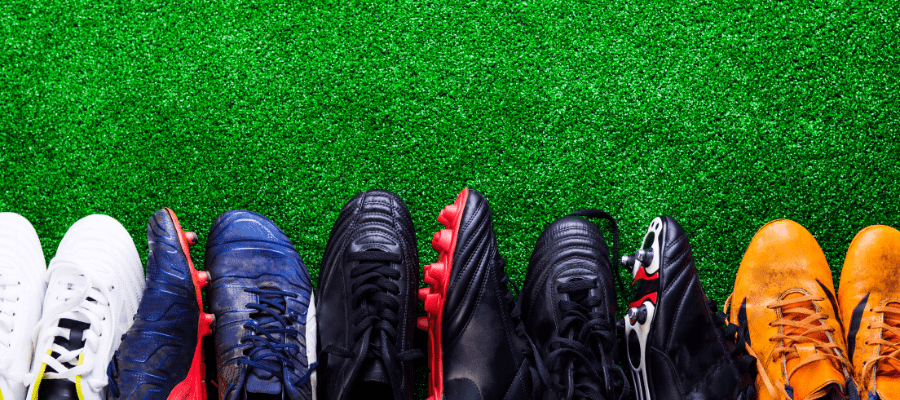Kicking off the soccer season in 2024 requires more than just skill and passion; it demands the right gear, starting with the cleats. Understanding the pivotal role of soccer cleats is crucial for young players’ development and safety. This year brings innovative advancements in soccer footwear technology, choosing the right cleat more important than ever. In our comprehensive guide, we’ll navigate through the latest in cleat technology, emphasizing how to choose the best pair for youth development and safety, ensuring your young athletes are both comfortable and secure on the field. Let’s lace up and dive into the essential knowledge for selecting the perfect youth soccer cleats in 2024.
Step-by-Step Guide to Selecting Youth Soccer Cleats
Here’s a structured, detailed step-by-step guide to selecting soccer cleats for young players:
- Assessing Player Position and Play Style:
- Forwards: Look for lightweight cleats for speed and agility.
- Midfielders: Cleats with good control and comfort for running.
- Defenders: Opt for cleats with more protection and stability.
- Goalkeepers: Choose cleats with good traction for quick lateral movements.
- Understanding Cleat Types and Their Intended Use Cases:
- FG (Firm Ground): Suitable for most grass fields.
- SG (Soft Ground): Ideal for wet, muddy surfaces.
- AG (Artificial Ground): Designed for synthetic fields.
- HG (Hard Ground): For hard, dry surfaces.
- IN/IT (Indoor): For indoor or flat surfaces.
- The Step-by-Step Process of Selection, from Research to Purchase:
- Research: Start by understanding your child’s needs based on their position and playing style.
- Type Selection: Choose the cleat type that matches the surfaces they play on most often.
- Sizing: Ensure you know the correct size, considering growth and sock thickness.
- Fit Trial: If possible, try on cleats with soccer socks to check for comfort and fit.
- Quality Check: Look for durable materials and good construction.
- Purchase: Buy from reputable retailers or official brand stores.
- Aftercare: Teach proper maintenance to extend the lifespan of the cleats.
Sizing and Fit to Ensure Your Young Athlete’s Comfort and Performance
To ensure your young athlete’s comfort and performance, proper sizing and fit of soccer cleats are crucial. Here’s how to get it right:
- Measuring Foot Size: Measure both feet late in the day (feet swell throughout the day) and use the larger measurement. Consider width as well as length.
- Avoiding Common Sizing Mistakes: Don’t select cleats based solely on age or assume they’ll “grow into” them. Too large cleats can cause blisters and affect performance.
- Trying On and Testing Cleats:
- Wear soccer socks for the fitting.
- Check for a snug fit, with about a thumb’s width of space from the toe.
- Walk around and, if possible, perform some soccer-specific movements to ensure comfort and stability.
A good fit is essential to avoid foot problems and enhance the player’s performance on the field.
Safety First: Factors Affecting the Safety of Soccer Cleats
To prioritize safety in soccer cleats, focus on features that offer enhanced protection, materials that balance durability with comfort, and proper maintenance. Look for cleats designed with sturdy materials like reinforced toe boxes for impact protection. The construction should ensure stability, especially in the heel area to prevent ankle rollovers. Regularly inspect cleats for wear and tear, clean them after use, and store them properly to maintain their safety features and extend their durability. Ensuring cleats are well-maintained plays a critical role in preventing injuries and ensuring ongoing safety and performance.
Navigating the Variety of Cleat Options
When choosing soccer cleats, understanding the materials and types can significantly affect your decision. Synthetic materials offer lightweight durability and water resistance, ideal for varying weather conditions, while natural leather provides superior comfort and fit, adapting to the foot’s shape over time. Different cleat types cater to specific playing surfaces, affecting traction and performance. While premium brands often feature advanced technology and materials, the value lies in fitting your young athlete’s needs, comfort, and playing style, rather than the brand itself.
Making the Decision
When deciding on the right soccer cleats, consider player comfort, cleat material, appropriate type for playing surface, and overall fit. Balance these factors with the cost, ensuring you’re investing in quality that supports the player’s safety and performance without overspending. Utilize resources like expert reviews, sports forums, and fitting guides to make an informed choice, prioritizing features that meet the specific needs of your young athlete for a rewarding playing experience.
Read more at “The Youth Sports Hub”

Wow, I just thought you need to buy shoes with cleats for soccer, but didn’t realize that there were so many different types, dependant on the position that you play.
I guess it also has a lot to do with the type of turf you are playing on as well. I have seen some cases where the cleats were to ‘sticky’ and the players twist and hurt their knees as their feet don’t come with them.
Michel,
Thanks for reading my post. Cleats are not only footwear, but safety equipment as well. The right fitting cleats as well as the right sized cleats or turf soles can have a tremendous impact on safety on the field.
Thanks again,
Sincerely,
Coach